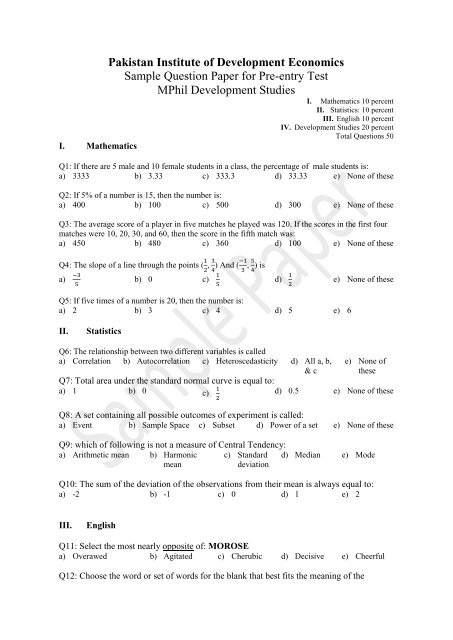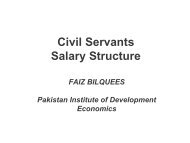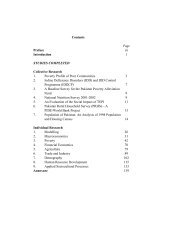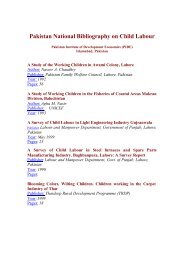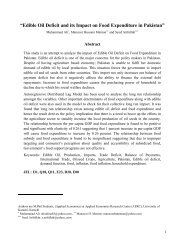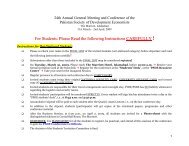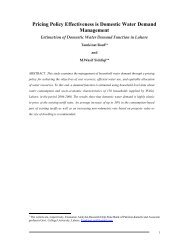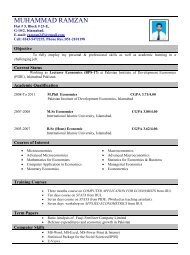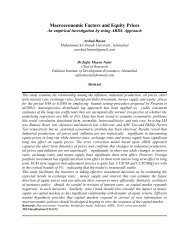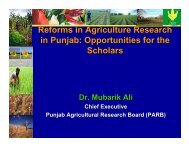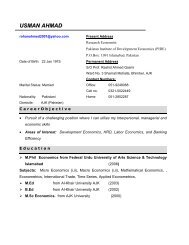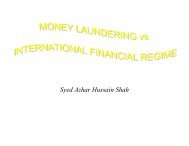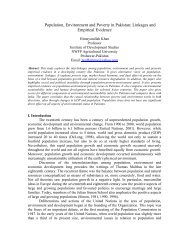Sample Paper for Pre-entry Test - Pakistan Institute of Development ...
Sample Paper for Pre-entry Test - Pakistan Institute of Development ...
Sample Paper for Pre-entry Test - Pakistan Institute of Development ...
You also want an ePaper? Increase the reach of your titles
YUMPU automatically turns print PDFs into web optimized ePapers that Google loves.
<strong>Pakistan</strong> <strong>Institute</strong> <strong>of</strong> <strong>Development</strong> Economics<br />
<strong>Sample</strong> Question <strong>Paper</strong> <strong>for</strong> <strong>Pre</strong>-<strong>entry</strong> <strong>Test</strong><br />
MPhil <strong>Development</strong> Studies<br />
I. Mathematics 10 percent<br />
II. Statistics: 10 percent<br />
III. English 10 percent<br />
IV. <strong>Development</strong> Studies 20 percent<br />
Total Questions 50<br />
I. Mathematics<br />
Q1: If there are 5 male and 10 female students in a class, the percentage <strong>of</strong> male students is:<br />
a) 3333 b) 3.33 c) 333.3 d) 33.33 e) None <strong>of</strong> these<br />
Q2: If 5% <strong>of</strong> a number is 15, then the number is:<br />
a) 400 b) 100 c) 500 d) 300 e) None <strong>of</strong> these<br />
Q3: The average score <strong>of</strong> a player in five matches he played was 120. If the scores in the first four<br />
matches were 10, 20, 30, and 60, then the score in the fifth match was:<br />
a) 450 b) 480 c) 360 d) 100 e) None <strong>of</strong> these<br />
Q4: The slope <strong>of</strong> a line through the points ( , ) And ( , ) is<br />
a) b) 0 c) d) e) None <strong>of</strong> these<br />
Q5: If five times <strong>of</strong> a number is 20, then the number is:<br />
a) 2 b) 3 c) 4 d) 5 e) 6<br />
II.<br />
Statistics<br />
Q6: The relationship between two different variables is called<br />
a) Correlation b) Autocorrelation c) Heteroscedasticity d) All a, b,<br />
& c<br />
e) None <strong>of</strong><br />
these<br />
Q7: Total area under the standard normal curve is equal to:<br />
a) 1 b) 0 c) d) 0.5 e) None <strong>of</strong> these<br />
Q8: A set containing all possible outcomes <strong>of</strong> experiment is called:<br />
a) Event b) <strong>Sample</strong> Space c) Subset d) Power <strong>of</strong> a set e) None <strong>of</strong> these<br />
Q9: which <strong>of</strong> following is not a measure <strong>of</strong> Central Tendency:<br />
a) Arithmetic mean b) Harmonic<br />
mean<br />
c) Standard<br />
deviation<br />
d) Median e) Mode<br />
Q10: The sum <strong>of</strong> the deviation <strong>of</strong> the observations from their mean is always equal to:<br />
a) -2 b) -1 c) 0 d) 1 e) 2<br />
III.<br />
English<br />
Q11: Select the most nearly opposite <strong>of</strong>: MOROSE<br />
a) Overawed b) Agitated c) Cherubic d) Decisive e) Cheerful<br />
Q12: Choose the word or set <strong>of</strong> words <strong>for</strong> the blank that best fits the meaning <strong>of</strong> the
sentence as a whole:<br />
Social tensions among the adult factions can be ________by politics, but<br />
adolescents and children have no such_________ <strong>for</strong> resolving their conflicts with<br />
the exclusive world <strong>of</strong> adults<br />
a) Intensified …<br />
attitude<br />
b) complicated<br />
… relief<br />
c) frustrated …<br />
justification<br />
d) adjusted…<br />
mechanism<br />
e) revealed…<br />
opportunity<br />
Q13: Select the lettered pair that best expresses a relationship similar to that between<br />
ADULT:: CHILD<br />
a) horse : mare b) cat : kitten c) swine : sow d) human :<br />
animal<br />
e) cow : herd<br />
Q14: Read following paragraph to answer Questions 14a to 14c:<br />
The dark regions in the starry night sky are not pockets in the universe that are<br />
devoid <strong>of</strong> stars as had long been thought. Rather they are dark because <strong>of</strong><br />
interstellar dust that hides the stars behind it. Although its visual effect is so<br />
pronounced, dust is only a minor constituent <strong>of</strong> the material, extremely low in<br />
density that lies between the stars. Dust accounts <strong>for</strong> about one percent <strong>of</strong> the total<br />
mass <strong>of</strong> interstellar matter. The rest is hydrogen and helium gas with small amounts<br />
<strong>of</strong> other elements. The interstellar material, rather like terrestrial clouds, comes in<br />
all shapes and sizes. The Average density <strong>of</strong> interstellar material in the vicinity <strong>of</strong><br />
our Sun is 1,000 to 10,000 times less than the best terrestrial laboratory vacuum. It<br />
is only because <strong>of</strong> the enormous interstellar distances that so little material per unit<br />
<strong>of</strong> volume becomes so significant. Optical astronomy is most directly affected, <strong>for</strong><br />
although interstellar gas is perfectly transparent, the dust is not.<br />
Q 14a: According to the passage, which <strong>of</strong> the following is a direct perceptual consequence<br />
<strong>of</strong> interstellar dust?<br />
a) Some stars are rendered invisible to<br />
b) Many visible stars are made to<br />
observers on Earth<br />
seem brighter than they really are.<br />
c) The presence <strong>of</strong> hydrogen and helium gas d) The night sky appears dusty all<br />
is revealed<br />
the times to observers on Earth<br />
e) The dust is conspicuously visible against a<br />
background <strong>of</strong> bright stars<br />
Q 14b: It can be inferred from the passage that the density <strong>of</strong> interstellar material is<br />
a) Higher where distances between the stars b) Equal to that <strong>of</strong> interstellar dust<br />
are shorter<br />
c) Usually low in the vicinity <strong>of</strong> our Sun d) Independent <strong>of</strong> the incidence <strong>of</strong><br />
gaseous components<br />
e) Not homogenous throughout interstellar<br />
space<br />
Q14c: It can be inferred from the passage that it is because space is so vast that<br />
a) Little <strong>of</strong> the interstellar material in it seems b) Normal units <strong>of</strong> volume seem<br />
substantial<br />
futile <strong>for</strong> measurement <strong>of</strong> density<br />
c) Starts can be far enough from Earth to be d) Interstellar gases can. For all<br />
obscured even by sparsely distributed<br />
practical purposes, be regarded as<br />
matter<br />
transparent<br />
e) Optical astronomy would be <strong>of</strong> little use<br />
even if no interstellar dust existed
IV.<br />
<strong>Development</strong> Studies<br />
Q15: In social research methodology, PRA stands <strong>for</strong><br />
a) Personal Research Art b) <strong>Pre</strong> Research Arrangements<br />
c) Post Research Arrangements d) Participatory Rural Appraisal<br />
e) None <strong>of</strong> the Above<br />
Q16: In development and economics field <strong>of</strong> studies, Amartya Sen is best known <strong>for</strong><br />
a) Right based approach b) Capability approach<br />
c) Need-based approach d) Participatory approach<br />
e) None <strong>of</strong> these<br />
Q Which <strong>of</strong> the following is not included in the World Bank Group<br />
a) International Monitory Fund (IMF) b) The International Centre <strong>for</strong><br />
Settlement <strong>of</strong> Investment<br />
Disputes (ICSID)<br />
c) International <strong>Development</strong> Association<br />
(IDA)<br />
e) Multilateral Investment Guarantee Agency<br />
(MIGA)<br />
d) The international Finance<br />
Corporation (IFC)<br />
Q18: In Millennium <strong>Development</strong> Goals, health is directly addressed in<br />
a) Goal 4 b) Goal 5<br />
c) Goal 6 d) All a, b & c<br />
e) None <strong>of</strong> a, b & c<br />
Q19: Green Revolution can be best described as<br />
a) A combination <strong>of</strong> research, development,<br />
and technology transfer in agricultural field<br />
c) A belief that agriculture is superior to<br />
industry and service sectors<br />
e) None <strong>of</strong> a, b, c & d<br />
b) Reborn <strong>of</strong> traditional agricultural<br />
practices<br />
d) A belief that large scale<br />
agricultural farms should be<br />
preferred over the small scale<br />
agricultural farms<br />
Q20: In gender studies, the term ‘Glass Ceiling’ normally refers to<br />
a) inequality in wages between men and<br />
women <strong>of</strong> the same educational level<br />
b) A description <strong>of</strong> traditional gender roles c) All a, b & c<br />
d) None <strong>of</strong> a, b & c<br />
a) Cultural barrier on men and<br />
women to marry with a person <strong>of</strong><br />
their choice<br />
Good luck <strong>for</strong> your preparation


